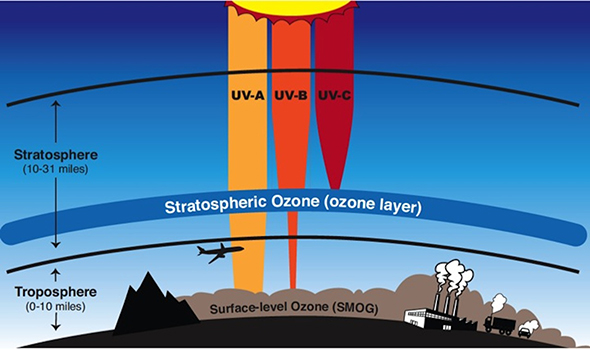Ozone introduction
This introduces you to ozone science: why ozone is important for our everyday life, what is ozone assessment. We present then our O3as service, how it can be used for simple analysis and a more advanced one. In the advanced section we show the underlying software technologies we are using.
Role of ozone for our life

The ozone layer in the stratosphere shields life on Earth from most UV-B and UV-C, the most harmful varieties of ultraviolet radiation. Credit: NASA
Ozone is a trace gas in the Earth’s atmosphere, that means that it only occurs in very small quantities on Earth. Trace gases are gases that are not nitrogen (78.1%), oxygen (20.9%) or argon (0.934%), i.e. they make up only about 0.066% of the atmosphere (not including water which makes up about 4%). If all the ozone were compressed to the pressure at the Earth’s surface (at 1013 hPa and 0°C) then the atmospheric content of ozone would make up a layer of 3 mm (which is equivalent to 300 Dobson Units (DU)). The highest content of ozone is found in the stratosphere at a height of about 25 to 30 km where the concentrations are about 10 parts per million parts of air (ppm), i.e. 0.001%.
The ozone present in the stratosphere at about 25 to 30 km is what makes up most ozone in the atmosphere. This ozone is important for life on planet Earth because it is responsible for removing most of the harmful ultraviolet (UV) radiation from the Sun. The longwave UV-A radiation (about 315–400 nm) is not absorbed, medium range UV-B radiation (about 280–315 nm) is mostly absorbed and the most dangerous shortwave UV-C radiation (about 100–280 nm) is totally absorbed by the ozone layer. A decrease in the ozone layer increases the amount of UV-B radiation reaching the Earth’s surface and the risk of skin cancer. Since UV radiation not only has an effect of the health of human beings it also has an effect on vegetation it is important to monitor stratospheric ozone.
Ozone hole and ozone assessment
With support of the World Meteorological Organization (WMO), the United Nations Environment Programme (UNEP), NASA, NOAA, and the European Commission periodic assessments of the state of ozone in the stratosphere are produced. Monitoring and the assessment of stratospheric ozone was started after the discovery of the ozone hole in the early eighties. Realizing that the decline of stratospheric ozone was due to harmful ozone destroying substances (ODSs) consisting of chlorofluorocarbons (CFCs) and hydrochlorofluorocarbons (HCFCs) the Montreal protocol (1987) and successor protocols were established to gradually curb the production of ODSs. The first assessment of the state of ozone was published in 1985, since 1994 they appear quadrennially.